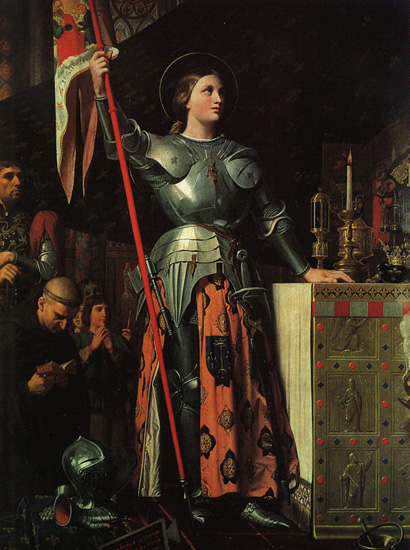Joan was a peasant farmer’s daughter from eastern France. The third of five children, Joan grew up with no education other than religion. From a young age, Joan heard the voices of saints, including St. Margaret. The saints ordered her to lead the French resistance to the English invasion in the Hundred Years War and assist the King of France in regaining his kingdom.
While she led an army towards many military successes, Joan was eventually captured and tried as a heretic, sorceress, and adulteress. She was burned at the stake in 1431 at the age of 19 years old.
However, in a second posthumous trial in 1456, she was found innocent of the charges against her. Joan was beatified in 1909 and canonized in 1920 by Pope Benedict XV. She is the patron saint of France and of soldiers.

Joan Interrogated in her Prison Cell by Cardinal Winchester, Hippolyte Delaroche, 1824, Oil on canvas, Museè des Beaux-Arts, Rouen. WikiCommons.
In this painting by Hippolyte (later Paul) Delaroche, Joan’s trial in the English-backed church court at Rouen is depicted. Joan is desperately praying, under the interrogating eyes of the fierce Cardinal, while awaiting her execution. She must have been truly frightened, having had her soldier’s armor removed, which would have been her identity and only protection from sexual assault while imprisoned.
The contrast of colors in Delaroche’s work is what first stands out. Cardinal Winchester is dressed in the red robes of his office, luxuriously draped around him as he sits in a chair. Behind him stands a scribe, recording the details of this interrogation but shrouded in darkness. On the right sits Joan upon a pile of hay, dressed in white (symbolic of her virtue) but stripped of any symbols of her bravery and importance on the battlefield. Her eyes are looking upwards, not at the cardinal, that combined with her clasped hands tell us that she is praying. It is perhaps why the cardinal appears so angry: she is not only a woman who has helped defeat his country’s armies, but also one who ignores his status as a cardinal and his questions in favor of praying to God.

Joan at the coronation of Charles VII, Jean Auguste Dominique Ingres, 1854, Oil on canvas, Louvre Museum, Paris, WikiCommons.
In this painting by Jean Auguste Dominique Ingres, Joan of Arc holds her standard as she attends the coronation of Charles VII, the dauphin whose title to the throne she fought for. She stands at the altar during the coronation, with several praying figures and a soldier-like figure behind her. Her position at the altar is notable, as women were not typically allowed near the altar except during marriage ceremonies. Her presence there is indicative of her high status within the church and to the French. She is likely also very close to Charles VII, who would have been on the altar during his coronation, and thus her position also emphasizes her closeness to the new king. Her helmet and gloves sit on the floor beside her. She carries her standard, emphasizing her role as a leader in battle.
At the time that he painted this work, Ingres was following a popular trend of adding more feminine elements to Saint Joan’s appearance. In this case, her long hair and skirted armor. The work also follows the trend of later artists in taking “artistic license” to edit historical details, as Joan is depicted in plate armor, which she never would have worn in real life. Notably, the plate armor is also modified for a distinctly female form with a small waist.
